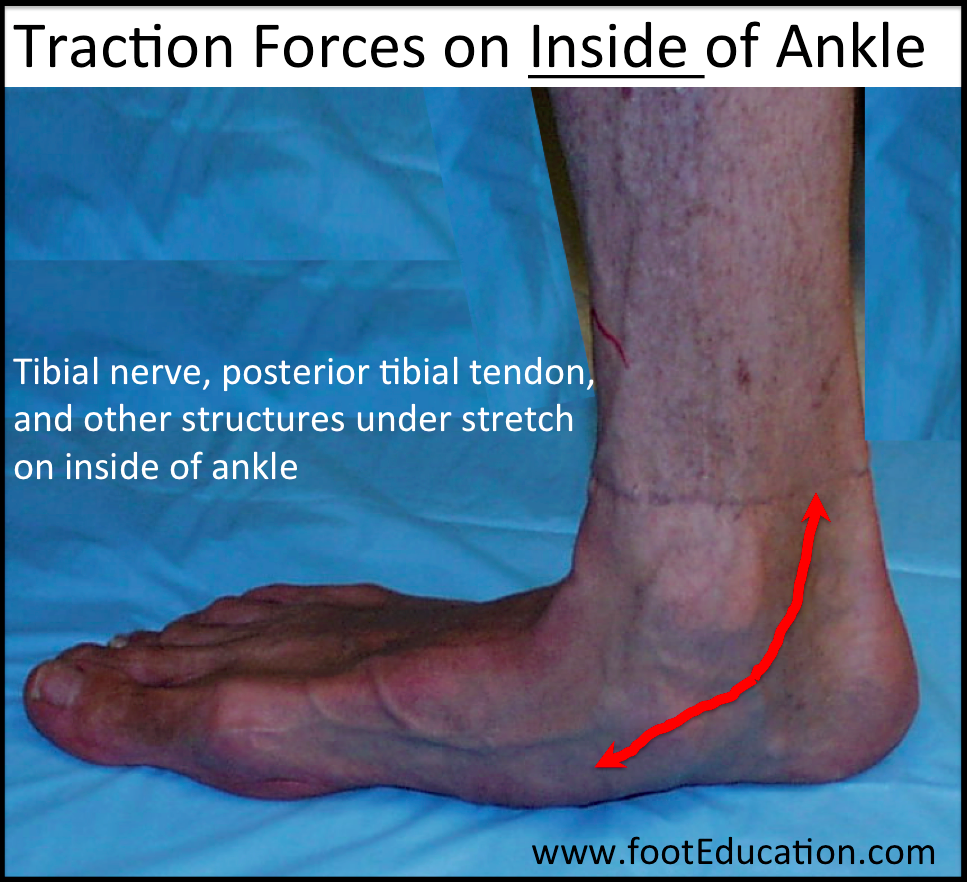Characteristics of a FlatFoot (Flatfeet)
Approximately 30 percent of the population have a moderately to extremely flat foot type. As the name suggests, a flatfoot is one where most of the sole of the foot is touching the ground during standing. Most flatfeet are painless. However, over time some people with a flatfoot deformity will develop chronic foot conditions such as posterior tibial tendonitis. Flatfooted people have feet with the following characteristics:
- Heel points outward from the ankle (valgus heel)
- Floppier and suppler foot due to an excess of movement in the midfoot region.
There are two primary reasons why someone would have a flat foot.
1. Medial Column Hypermobility
In some individuals, the inner part of the foot (the “medial column”) has too much motion. The medial column is essentially the inside part of the foot – all the structures in the foot that line up with the big toe. When the medial column is floppy the base of the great toe fails to take its share of the weight during gait, allowing the arch of the foot to collapse (Figure 1).

2. A Tight Calf Muscle (Gastrocnemius Equinus Contracture)
The second major cause of a flat foot is a very tight and inflexible calf muscle. In this case, the foot will flex up through the ankle joint (dorsiflexion) toward the person and quickly meet resistance from the tight calf muscle. If the ankle joint does not allow for adequate upward flexing (dorsiflexion) due to a tight calf muscle then the foot rotates upward around the joint in front of the ankle (the talonavicular joint). However, the talo-navicular joint not only moves up and down, it also moves to the outside. This rotates the front part of the foot to the outside (abduction) causing the arch to collapse inwards. A tight calf muscle (usually hereditary) is a fairly common cause of flat foot. Pediatric flatfoot (flexible flatfoot in a child) is almost always associated with a very tight calf muscle. This condition is often asymptomatic but sometimes worrying to parents.
These two causes of a flatfoot deformity are often related and both seem related to the evolution of the foot. This explains why many people with flat feet also have a parent or grandparent with flatfeet.
FlatFoot Symptoms
During walking, there is two to three times the weight of the body going through the foot. This force can take the form of pulling (traction) forces, which act on ligaments and tendons (Figure 2) or jamming (compression) forces, which act through the joints (Figure 3). Because there is so much movement in the medial column with flat footed people, all the tendons on the inside of the ankle (especially the posterior tibial tendon) have to work extra hard to pull the foot into the shape of a rigid lever prior to the foot pushing off the ground during gait. As a result of the exaggerated traction forces acting on the inside of the ankle, flat-footed people are much more likely to develop problems related to repetitive overload of the structures on the inside of the ankle and arch. These problems include: posterior tibialis tendonitis (acquired adult flatfoot deformity), tarsal tunnel syndrome, and plantar fasciitis (a list commonly known as the terrible triad).

The compression forces associated with a flat foot go through the outside of the ankle joint. These forces can actually squash the outside of the ankle to such a degree that it may eventually wear out the outside of the ankle joint leading to ankle arthritis. In the same way, there is also often painful compression in the outside front part of the subtalar joint (the joint below the ankle joint) leading to a condition that is commonly called sinus tarsi syndrome.

In addition, it is also common for flatfooted people to experience repetitive overload of the bases of the second toe because the base of the great toe does not take its share of the weight during each step. This “transfers” the force to the base of the second toe potentially leading to overload metatarsalgia or even a second metatarsal stress fracture.
Edited by Stephen Pinney MD. October 25th, 2025.